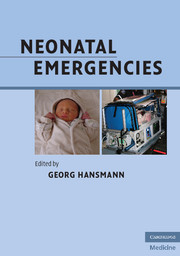Book contents
- Frontmatter
- Contents
- List of contributors
- Foreword (1)
- Foreword (2)
- Preface
- Acknowledgments
- Section 1 Organization of neonatal transport
- Section 2 Basics in cardiopulmonary resuscitation of newborn infants
- Basic equipment setup for initial neonatal care and resuscitation
- Drugs for neonatal emergencies
- Postnatal cardiopulmonary adaptation
- ABC Techniques and Procedures
- Sunctioning
- Stimulation, oxygen supplementation, bag-and-mask ventilation (M-PPV), pharyngeal/bi-nasal CPAP, and pharyngeal positive pressure ventilation
- Endotracheal intubation and gastric tube placement
- Laryngeal mask airway (LMA)
- Chest compressions
- Peripheral venous access
- Umbilical vein/artery catheterization (UVC, UAC)
- Central venous access (internal jugular vein)
- Intraosseous access
- Cord clamping
- Management of high-risk infants in the delivery room
- Monitoring in the delivery room and during neonatal transport
- Hygiene in the delivery room and during neonatal transport (infection control)
- When to call a pediatrician to the delivery room
- Checklist for the postnatal treatment of newborn infants
- Assigning individual duties in the delivery room
- Clinical assessment of the newborn infant
- Cardiopulmonary resuscitation of newborn infants at birth
- Volume therapy and sodium bicarbonate supplementation in preterm and term newborn infants
- Absolute and relative indications for neonatal transport and NICU admission
- Communication with mother and father
- Coordinating neonatal transport and patient sign-out to the NICU team
- Documentation and feedback after neonatal emergency transport
- Ethics in neonatal intensive care
- Perinatal images of preterm and term infants
- Mechanical ventilation of the neonate
- Questions for review (basics)
- References (Section 2)
- Section 3 Classic and rare scenarios in the neonatal period
- Section 4 Transport
- Section 5 Appendix
- Index
- Plate section
Sunctioning
from Section 2 - Basics in cardiopulmonary resuscitation of newborn infants
Published online by Cambridge University Press: 05 March 2012
- Frontmatter
- Contents
- List of contributors
- Foreword (1)
- Foreword (2)
- Preface
- Acknowledgments
- Section 1 Organization of neonatal transport
- Section 2 Basics in cardiopulmonary resuscitation of newborn infants
- Basic equipment setup for initial neonatal care and resuscitation
- Drugs for neonatal emergencies
- Postnatal cardiopulmonary adaptation
- ABC Techniques and Procedures
- Sunctioning
- Stimulation, oxygen supplementation, bag-and-mask ventilation (M-PPV), pharyngeal/bi-nasal CPAP, and pharyngeal positive pressure ventilation
- Endotracheal intubation and gastric tube placement
- Laryngeal mask airway (LMA)
- Chest compressions
- Peripheral venous access
- Umbilical vein/artery catheterization (UVC, UAC)
- Central venous access (internal jugular vein)
- Intraosseous access
- Cord clamping
- Management of high-risk infants in the delivery room
- Monitoring in the delivery room and during neonatal transport
- Hygiene in the delivery room and during neonatal transport (infection control)
- When to call a pediatrician to the delivery room
- Checklist for the postnatal treatment of newborn infants
- Assigning individual duties in the delivery room
- Clinical assessment of the newborn infant
- Cardiopulmonary resuscitation of newborn infants at birth
- Volume therapy and sodium bicarbonate supplementation in preterm and term newborn infants
- Absolute and relative indications for neonatal transport and NICU admission
- Communication with mother and father
- Coordinating neonatal transport and patient sign-out to the NICU team
- Documentation and feedback after neonatal emergency transport
- Ethics in neonatal intensive care
- Perinatal images of preterm and term infants
- Mechanical ventilation of the neonate
- Questions for review (basics)
- References (Section 2)
- Section 3 Classic and rare scenarios in the neonatal period
- Section 4 Transport
- Section 5 Appendix
- Index
- Plate section
Summary
The following techniques and procedures are described in this subsection: suctioning, stimulation, oxygen supplementation, bag-and-mask ventilation, pharyngeal and bi-nasal continuous positive airway pressure (CPAP), pharyngeal positive pressure ventilation, endotracheal intubation, gastric tube placement, laryngeal mask airway (LMA) placement, chest compressions, peripheral venous access, umbilical vein/artery catheterization, central venous access (IJ), intraosseous access, and cord clamping. For chest tube placement see chapter entitled “Pneumothorax.”
A vigorous newborn infant born out of clear amniotic fluid who begins to cry within 5-10s after birth does not need to be suctioned.
Unnecessary suctioning is uncomfortable for the infant and may cause lesions in the mucous membrane and occasionally a vagal reflex with subsequent bradycardia, laryngeal spasm and apnea.
Indications for suctioning of the upper respiratory tract
Excessive amount of amniotic fluid in the oropharynx (e.g., after C-section)
Green-stained, bloody or smelly fluid
Prematurity (i.e., preterm newborn infants usually need suctioning)
Abnormal adaptation, respiratory distress or apnea
Polyhydramnion
Visualization of vocal cords during intubation
The A of the ABCD measures stands for Airways: term or preterm infants with respiratory distress, apnea or bradycardia need rapid clearing of their airways by suctioning.
Rule of thumb for the suctioning of newborn infants(Figure 2.16 and 2.17)
Always suction the mouth/throat before the nose: Nasal suctioning is a strong stimulus that may lead to aspiration of fluid that is still in the hypopharynx
Avoid deep (i.e., hypopharyngeal or esophagogastric) suctioning in the first 5 min after birth: Vagal reflex resulting in bradycardia, laryngeal spasm and apnea is possible. Suction only as needed (see above)!
A vigorous, active, and healthy neonate should be dried, wrapped up and then given to the mother. Attempt to pass naso- or orogastric tube through the esophagus into the stomach 10–30 min after birth (i.e., before the first feeding)
[…]
- Type
- Chapter
- Information
- Neonatal Emergencies , pp. 67 - 70Publisher: Cambridge University PressPrint publication year: 2009



